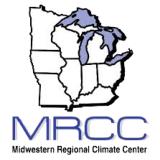Potential for Rapid Intensification of Drought in the Midwest
Key Points
- A record-breaking heat wave has been making its way across the central U.S. this week, with temperatures peaking in the Midwest on Tuesday and Wednesday with widespread temperatures from 90–100°F.
- Above-normal temperatures are expected to continue through at least the end of June, according to NOAA’s Climate Prediction Center (Figure 1). Below-normal precipitation is also expected across much of the Midwest during this same time period (Figure 2).
- While the Midwest region is currently almost entirely drought-free, there are some areas of concern that are abnormally dry (Illinois, Indiana, Kentucky, and Missouri). In addition, portions of western Iowa remain in moderate to severe drought (D1–D2) (Figure 3).
- However, the forecasted hot and dry conditions will likely lead to the rapid intensification of drought conditions in portions of the Midwest over the next few weeks (Figure 4). This rapid intensification of drought is sometimes called "flash drought." Flash drought is set in motion by below-normal precipitation, accompanied by abnormally high temperatures, winds, and/or solar radiation.
- Potential impacts of the heat and rapid intensification of drought include: reduced moisture/drying soils for agriculture and lawns/gardens, human and animal health issues related to the heat, negative ecological impacts, increased potential for wildfire and stress on the energy system.
- In the longer term, the outlooks are favoring the continuation of hot and dry conditions for most of the region into July, as well as the July–September time frame. As a result, the seasonal drought outlook indicates that drought development is likely over portions of Illinois, Indiana, Kentucky, and Missouri, and persistence and further development in Iowa (Figure 5).
Figure 1. 8–14 Day Temperature Outlook (Valid June 24–30, 2022)

Figure 2. 8–14 Day Precipitation Outlook (Valid June 24–30, 2022)

Figure 3. U.S. Drought Monitor (June 14, 2022)

Figure 4. 8–14 Day U.S. Hazards Outlook (Valid June 24–30, 2022)

Figure 5. U.S. Seasonal Drought Outlook (June 16–September 30, 2022)

Resources for Monitoring Flash Drought
- What is flash drought?
- Keep track of the risk of rapid drought intensification with the U.S. Hazards Outlook.
- Keep track of how much soil moisture there is compared to normal with NASA’s SPoRT-LIS map.
- Keep track of temperatures across the region with the Midwest Climate Watch Daily Maps.
Heat Health Resources
- Climate and Health Outlook – June 2022 from Health and Human Services.
- Heat illness prevention information from the National Integrated Heat Health Information System (NIHHIS).
- Tips on staying safe in extreme heat from the Centers for Disease Control and Prevention (CDC).
- Heat safety tips and resources from the National Weather Service.
For More Information
- NIDIS and its partners will issue future updates as conditions evolve.
- More local information is available from the following resources:
- To report or view local drought impact information:
- Report your drought impacts through Condition Monitoring Observer Reports (CMOR)
- View CoCoRaHS Condition Monitoring reports.
- The upcoming North Central U.S. Climate and Drought Summary & Outlook Webinar on July 21, 2022 will offer updated information about conditions, impacts, and outlooks. The recordings for the webinar can be found here.
Prepared By
Molly Woloszyn
NOAA/National Integrated Drought Information System (NIDIS)
Dennis Todey
USDA Midwest Climate Hub
Doug Kluck
NOAA/National Centers for Environmental Information
Melissa Widhalm
Midwestern Regional Climate Center/Purdue University
Ray Wolf & Audra Bruschi
NOAA/National Weather Service
This drought status update is issued in partnership between the National Oceanic and Atmospheric Administration (NOAA) and the U.S. Department of Agriculture (USDA) to communicate a potential area of concern for drought expansion and/or development within the Midwest U.S. based on recent conditions and the upcoming forecast. NIDIS and its partners will issue future drought status updates as conditions evolve.









